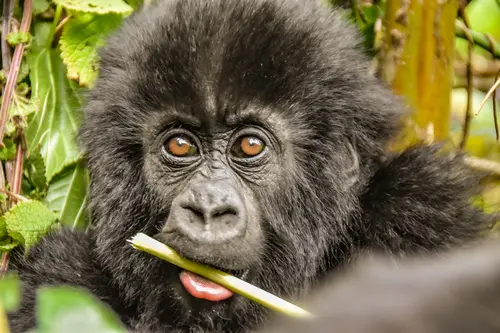How Gorillas Live In Their Natural Habitat
How Gorillas Live In Their Natural Habitat, Bwindi impenetrable national park lies in southwestern Uganda. It covers 321 square kilometers shared Kanungu, Kabale, and Kisoro districts. It is one of Africa’s oldest forests and has been ranked by UNESCO as a world heritage site.
The forest lies in the Albertine Rift endemic area implying that it holds endemic species of creatures most of them being the endangered Mountain gorillas.
Uganda is known to many visitors as one of the most beautiful countries in Africa. Due to its numerous wildlife and ecosystems ranging from the forests of Bwindi. And the plains to permanent swamps, and other mosaic habitats that support a variety of wildlife.
However, the buffer zones of Bwindi’s impenetrable national park are surrounded by community and due to the frequent interaction between people and the Gorillas. There might be some disease outbreaks that may not only be dangerous to the people. But also to the endangered Mountain gorillas. This, therefore, has called for public health awareness in the Bwindi area. To help sensitize the communities about the conservation of the Gorillas and the health of the people around them.
GOVERNMENT PROGRAMS/PROJECTS
Many programs have been put in place to help in the health of the Gorillas. However, there is a Non-governmental organization that has closely worked with Gorilla and people’s health in the Bwindi Community. How Gorillas Live In Their Natura, Buhoma Sector.
Conservation Through Public Health [CTPH] is a non-government organization on the ground ensuring the health of the people around the gorillas and that of gorillas as well. It works closely with Range Land Safaris which is a community-rewarding Safari Company in Uganda.
The organization has a number of projects running in the community including coffee processing, and accommodation provision that is used as an activity to boost the income of the locals. It has Gorilla doctors whom Range Land Safaris recommends for your experience with the Gorillas at a small cost that helps to care for the community and the gorillas’ health.
CONSERVATION OF GORILLAS
Conservation Through Public Health was established with its main objective is contributing to wildlife research, sustainable conservation, and development initiatives. Their vision is for People, How Gorillas Live In Their Natural, wildlife, and livestock to live in balance, health, and in harmony. With local communities acting as stewards of their environment.
Your Gorilla experience with Range Land Safaris will closely bring you to the experience of the local’s involvement in the conservation of gorillas and public health.
SOME OF THE FREQUENTLY ASKED QUESTIONS ABOUT GORILLAS.
1. WHAT DO GORILLAS FEED ON?
Mountain gorillas are vegetarians and they feed on bamboo, trees, and fruits. They also feed on ants and termites. They spend most of the time on the grounds but also climb up to reach for food. These gentle giants can survive without water for a long time. Silverback can eat 30kg a day.
2. HOW DO GORILLAS LIVE?
Most families contain 10-15 members and usually a silverback is the head of a family and decides the movement of the day. The largest habituated group in Bwindi impenetrable forest contains 26 members while Rwanda has 28 members. Conflicts among gorilla groups are not common because they are not territorial.
3. WHAT ARE GORILLA TRACKING HEALTH REQUIREMENTS?
Mountain Gorillas are highly susceptible to human diseases including flu and colds. If you are participating in a gorilla. Then you need to be free of any easily contagious diseases. And this is checked at the start of the trek by the Park Authorities. If they are in any doubt of your condition, they reserve the right to prevent you from continuing on the trek.
4. WHAT IS THE GORILLA TREKKING AGE LIMITS?
The age limit for gorilla tracking, is 15 years and the authorities are very strict on this, kindly make sure all clients and children are 15 or older in order to avoid any sad incidents like guest(s) kids being refused to track!
5. WHAT TO PACK FOR GORILLA TREKKING?
While gorilla and chimp tracking you will need a comfortable, hard-wearing, pair of walking shoes or boots – with good tread and support. Conditions are generally muddy/slippery. There are uphill sections which may be quite steep and strenuous. It is also advisable to wear a long-sleeved shirt and lightweight long trousers to protect yourself from the undergrowth, stinging nettles, and biting ants.
(Tracksuit pants often get caught on bushes, thorns, etc. and jeans can get very heavy when wet). Gloves are also highly recommended – just cheap gardening gloves will do – this will prevent your hands from being scratched when holding onto vegetation for support, How Gorillas Live In Their Natural, through dense parts of the forest. Tuck your long pants into your socks/boots to avoid biting insects.
Your clothes will in all likelihood get very muddy and may not recover to their original state – therefore take old clothing for the gorilla trekking. A poncho or lightweight rain jacket is useful, and a day-pack to carry your lunch, water, and camera gear in. Walking sticks are made available at the start of the trek for some of the steeper and more slippery tracks and may prove, Binoculars are generally not needed for gorilla viewing, but very handy if you are a keen bird-watcher, Plenty of water – 1-2 liters per person, High energy snacks in addition to your packed lunch provided by the lodge /Camp.
6. HOW MUCH IS A GORILLA PERMIT?
A gorilla permit costs 700 USD for Non-Residents, Foreign residents 600 USD, and East African residents 250.0000 Ugandan shillings.

